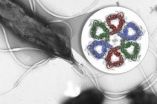(Press-News.org) Experiments at the U.S. Department of Energy's (DOE) SLAC National Accelerator Laboratory have revealed a potential new way to attack common stomach bacteria that cause ulcers and significantly increase the odds of developing stomach cancer.
The breakthrough, made using powerful X-rays from SLAC's Stanford Synchrotron Radiation Lightsource (SSRL), was the culmination of five years of research into the bacterium Helicobacter pylori, which is so tough it can live in strong stomach acid. At least half the world's population carries H. pylori and hundreds of millions suffer health problems as a result; current treatments require a complicated regimen of stomach-acid inhibitors and antibiotics.
"We were looking for a means to disrupt H. pylori's own mechanism for protecting itself against stomach acid," said Hartmut "Hudel" Luecke, a researcher at the University of California, Irvine, and principal investigator on the paper, published online Dec. 9 in Nature. With this study, he said, "We have deciphered the three-dimensional molecular structure of a very promising drug target."
Luecke and his team zeroed in on tiny channels that H. pylori uses to allow in urea from gastric juice in the stomach; it then breaks this compound into ammonia, which neutralizes stomach acid. Blocking the channels would disable this protective system, leading to a new treatment for people with the infection.
Solving the structure of the protein to find the specific area to target wasn't easy. The channels are formed by the protein embedded in the bacterium's cell membrane, and membrane proteins are notoriously difficult to crystallize, which is a prerequisite for using protein crystallography, the main technique for determining protein structures. This technique bounces X-rays off of the electrons in the crystallized protein to generate the experimental data used to build a 3-D map showing how the protein's atoms are arranged.
The challenge with membrane proteins is that they are especially hard to grow good quality crystals of, and for this experiment, said Luecke, "We needed to grow and screen thousands of crystals."
"We collected over 100 separate data sets and tried numerous structural determination techniques," said Mike Soltis, head of SSRL's Structural Molecular Biology division, who worked with Luecke and his team to create the 3-D map of the atomic structure. The final data set was measured at SSRL's highest brightness beam line (12-2), which produced the critical data that met the challenge.
"This is the hardest structure I've ever deciphered, and I've been doing this since 1984," Luecke said. "You have to try all kinds of tricks, and these crystals fought us every step of the way. But now that we have the structure, we've reached the exciting part—the prospect of creating specific, safe and effective ways to target this pathogen and wipe it out."
INFORMATION:
This work was supported by the National Institutes of Health, the National Cancer Institute, the UC Irvine Center for Biomembrane Systems and the US Veterans Administration. SSRL is supported by DOE's Office of Science, and the SSRL Structural Molecular Biology Program by DOE and NIH. The research team also included scientists from the University of California, Los Angeles (Greater West Los Angeles Health Care System).
The research paper is available online from Nature: http://www.nature.com/nature/journal/vaop/ncurrent/full/nature11684.html
SLAC is a multi-program laboratory exploring frontier questions in photon science, astrophysics, particle physics and accelerator research. Located in Menlo Park, California, SLAC is operated by Stanford University for the U.S. Department of Energy Office of Science. To learn more, please visit www.slac.stanford.edu.
DOE's Office of Science is the single largest supporter of basic research in the physical sciences in the United States, and is working to address some of the most pressing challenges of our time. For more information, please visit science.energy.gov.
Experiment finds ulcer bug's Achilles' heel
X-rays pinpoint drug target for bacteria that affect hundreds of millions worldwide
2012-12-10
ELSE PRESS RELEASES FROM THIS DATE:
Frankincense is for life, not just for Christmas
2012-12-10
At this time of year it is hard to escape the Three Wise Men, riding their camels across Christmas cards and appearing in minature form in countless school nativity plays across the world, bearing their gifts for the infant Jesus. Whilst we are all familiar with gold (especialliy in this Olympic year), it is the mention of frankincense and myrrh that really says "Christmas" to us and and takes our imaginations back to ancient times. But you might be surprised to learn that these two fragrances are still big business today; for example, Ethiopia alone trades around 4000 ...
Oxytocin produces more engaged fathers and more responsive infants
2012-12-10
Philadelphia, PA, December 10, 2012 – A large body of research has focused on the ability of oxytocin to facilitate social bonding in both marital and parenting relationships in human females. A new laboratory study, led by Dr. Ruth Feldman from Bar-Ilan University in Israel and published in the current issue of Biological Psychiatry, has found that oxytocin administration to fathers increases their parental engagement, with parallel effects observed in their infants.
Oxytocin is a neuropeptide that plays an important role in the formation of attachment bonds. Studies ...
Onion soaks up heavy metal
2012-12-10
Onion and garlic waste from the food industry could be used to mop up hazardous heavy metals, including arsenic, cadmium, iron, lead, mercury and tin in contaminated materials, according to a research paper published in the International Journal of Environment and Pollution.
Biotechnologists Rahul Negi, Gouri Satpathy, Yogesh Tyagi and Rajinder Gupta of the GGS Indraprastha University in Delhi, India, explain how waste from the processing and canning of onion (Allium cepa L.) and garlic (Allium sativum L.) could be used as an alternative remediation material for removing ...
Ultrasound can now monitor the health of your car engine
2012-12-10
A system that uses ultrasound technology to look inside car engines could lead to more efficient engines – and huge fuel savings for motorists.
Ultrasound scans have long been a fundamental tool in healthcare for looking inside the human body, but they have never before been put to use in testing the health of a modern combustion engine.
In the University of Sheffield's Department of Mechanical Engineering, Rob Dwyer-Joyce, Professor of Lubrication Engineering, has devised a method of using ultrasound to measure how efficiently an engine's pistons are moving up and ...
To make old skin cells act young again, boost their surroundings, U-M scientists show
2012-12-10
ANN ARBOR, Mich. — As we get older, the trillions of cells in our body do too. And like us, they become less resilient and able to weather the stress of everyday life. Our skin especially tells the tale of what's happening throughout our bodies.
But recently, scientists have learned that aging cells bear only part of the blame for this downward spiral. And a new study shows that it might be possible to slow the decline of aging tissue – and even make it act younger -- by focusing on the stuff that surrounds those cells.
In an independent study at the University of Michigan ...
Leading experts urge Europe to implement personalized medicine in healthcare
2012-12-10
Strasbourg, France, 10 December, 2012: Dedicated funding and support is required to ensure personalised medicine can be implemented across Europe's healthcare systems, according to a new report issued by the European Science Foundation's (ESF) membership organisation for all medical research councils in Europe, the European Medical Research Councils (EMRC).
The report entitled Personalised Medicine for the European Citizen, brought together experts from a wide range of disciplines to identify the most pressing issues affecting the development and implementation of personalised ...
Prospectus addresses most pressing marine science questions
2012-12-10
The most pressing issues that UK marine science needs to address over the next two decades are the subject of a prospectus published as a themed issue of the Philosophical Transactions of the Royal Society A last month. The volume is co-edited and carries contributions by scientists based at the National Oceanography Centre Southampton (NOCS).
Human-induced changes in ocean processes are already being observed, and are projected to intensify as demand for the ocean's resources continues to increase. The prospectus, introduced as `A strategy for UK marine science for ...
Just 28 percent of young people in Spain read either online or conventional newspapers each day
2012-12-10
A study at the Jaume I University in Castellón has verified the decrease in press consumption among young people between the ages of 16 and 30 years, which now stands at 28.8%. What is more, three out of every four individuals within this age bracket use social networking sites more than the television to get up to date.
News consumption habits among young people have changed radically in recent years. Since the beginning of the 21st century, various studies have indicated a decrease in readership of printed newspapers along with a constant fall in young readers.
"Just ...
Iron supplements reduce ADHD in low birth weight infants
2012-12-10
In a study published today in Pediatrics, scientists at Umeå University in Sweden conclude that giving iron supplements to low birth weight infants reduces the risk of behavior problems like ADHD later in life.
The study, Effects of Iron Supplementation on LBW Infants on Cognition and Behavior at 3 Years, is published in the January 2013 issue, released online Dec. 10, 2012.
In the randomized controlled trial, researchers in Sweden gave 285 marginally low birth weight infants either 0, 1 or 2 mg/kg and day of iron supplements from 6 weeks to 6 months of age. At age ...
Palliative care improves outcomes for seniors
2012-12-10
Seniors in long-term care experienced a significant reduction in emergency room visits and depression when receiving palliative care services, according to a recent collaborative study by researchers at Hebrew SeniorLife's Hebrew Rehabilitation Center (HRC) and Institute for Aging Research, both affiliated with Harvard Medical School (HMS).
The results of the study, published today in The Gerontologist, demonstrate the potential for improved end-of-life quality of care when palliative services are implemented in a long-term care setting.
The researchers analyzed the ...
LAST 30 PRESS RELEASES:
Injectable breast ‘implant’ offers alternative to traditional surgeries
Neuroscientists devise formulas to measure multilingualism
New prostate cancer trial seeks to reduce toxicity without sacrificing efficacy
Geometry shapes life
A CRISPR screen reveals many previously unrecognized genes required for brain development and a new neurodevelopmental disorder
Hot flush treatment has anti-breast cancer activity, study finds
Securing AI systems against growing cybersecurity threats
Longest observation of an active solar region
Why nail-biting, procrastination and other self-sabotaging behaviors are rooted in survival instincts
Regional variations in mechanical properties of porcine leptomeninges
Artificial empathy in therapy and healthcare: advancements in interpersonal interaction technologies
Why some brains switch gears more efficiently than others
UVA’s Jundong Li wins ICDM’S 2025 Tao Li Award for data mining, machine learning
UVA’s low-power, high-performance computer power player Mircea Stan earns National Academy of Inventors fellowship
Not playing by the rules: USU researcher explores filamentous algae dynamics in rivers
Do our body clocks influence our risk of dementia?
Anthropologists offer new evidence of bipedalism in long-debated fossil discovery
Safer receipt paper from wood
Dosage-sensitive genes suggest no whole-genome duplications in ancestral angiosperm
First ancient human herpesvirus genomes document their deep history with humans
Why Some Bacteria Survive Antibiotics and How to Stop Them - New study reveals that bacteria can survive antibiotic treatment through two fundamentally different “shutdown modes”
UCLA study links scar healing to dangerous placenta condition
CHANGE-seq-BE finds off-target changes in the genome from base editors
The Journal of Nuclear Medicine Ahead-of-Print Tip Sheet: January 2, 2026
Delayed or absent first dose of measles, mumps, and rubella vaccination
Trends in US preterm birth rates by household income and race and ethnicity
Study identifies potential biomarker linked to progression and brain inflammation in multiple sclerosis
Many mothers in Norway do not show up for postnatal check-ups
Researchers want to find out why quick clay is so unstable
Superradiant spins show teamwork at the quantum scale
[Press-News.org] Experiment finds ulcer bug's Achilles' heelX-rays pinpoint drug target for bacteria that affect hundreds of millions worldwide


